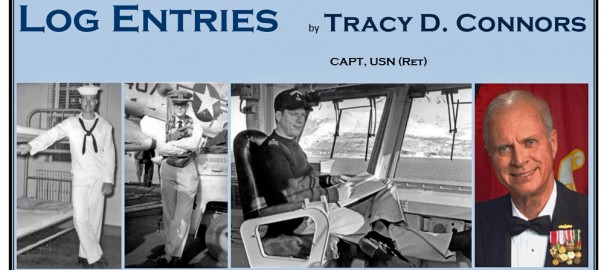Fish Gotta Swim, Tubes Gotta Blow
More boilers on line meant fewer opportunities for maintenance. For the Engineering Officer, keeping those precious boilers at peak performance capability was among his highest priorities.
Conventional boilers accumulated soot around the boiler tubes that were soaking up the heat that made the steam. Over time, the soot soon began to act as an insulator for the boiler tubes. Heat transfer dropped, and with it, boiler efficiency. For the soot to be removed, live steam was introduced into the boiler to “blow” the soot off the tubes and up the stack. The process was called “blowing tubes,” and was requested several times a day, based on operational tempo. The bridge watch team was very alert to the message on the 21 MC, “Bridge, Main Control, request permission to blow tubes.”
The result of blowing tubes was that the sooty “crud” wrapped around the boiler tubes would be sent boiling up the stack. Once out of the stack, it would follow the wind and begin to redeposit the crud on other surfaces. If these happened to include a flight deck, or an antenna array, or a polished aircraft, the hapless OOD would be in for a profanity heavy tongue lashing that would never be forgotten. That’s why Main Control would always ask permission before de-crudifying the boilers. That’s why OOD’s u/w gave serious thought and attention to blowing tubes. OOD Note to self: make damn sure when permitting “blow tubes” that the relative wind will take the crud away from any part of the ship.
On the day I fought my only close-up-and-personal battle of the Cold War in 1963, I had the “afternoon watch” (1200-1600) OOD during a day of heavy flight operations. The ship had been running up and down the wind all day, with no time to blow tubes. The crud was piling up. Several times the Engineering Officer of the Watch (EOOW) had called the bridge requesting permission to blow tubes. OpTempo would not allow it.
Early in my watch, the EOOW had requested to blow tubes and I could not allow it.
Meanwhile, we were running downwind to stay within our designated PIM (position and intended movement). I knew the damn “trawler” would be waiting on us to monitor and cause trouble if they could.
About ten minutes before I was to begin the looping turn that would bring us back around to Foxtrot Corpen (intended course for flight operations) and Foxtrot Speed (at that time, about 30 knots), the Chief Engineer himself called up to request permission to blow tubes. His request was closer to a demand, as he explained succinctly and somewhat saltily the cruddy reasons behind the request.
As he talked, I was doing what would later be called, “parallel processing.” I don’t know how the “dots” became connected between “trawler” and “blow tubes,” but they were.
Asking the ChEng to standby, I huddled (literally) with my watch team over the navigation table and outlined the possibilities. With you-know-what-eating grins, they got to work on the maneuvering board solutions. I crossed the bridge to brief the Captain. I asked for permission to blow tubes as we turned back into the wind. I also connected the cruddy “dots” for him between our stack, the position in the turn at which point engineering could be permitted to blow tubes, the direction of relative wind, and a certain “trawler.”
He grinned and nodded his head.
Blowing tubes it would be. The ChEng would simmer down and the trawler, if we planned it right, would soot up. Good trade.
© Copyright 2017-2022 BelleAire Press
Other works by Dr. Connors…
Baited Trap, the Ambush of Mission 1890
Now Available As E-Pub

Baited Trap, The Ambush of Mission 1890 is the story of helicopter rescue Mission 1890, one of the most heroic—and costly—air rescues of the Korean War. This harrowing Air Force-Navy mission is explained in compelling detail, creating a detailed personal account of what five incredibly brave and determined Air Force and Navy airmen achieved on June 25, 1952 in the infamous “Iron Triangle.”
The Korean War’s Greatest Love Story
Baited Trap is much more than a heroic war story from the “forgotten war.” It is also the Korean War’s greatest love story, following Wayne and Della Lear, Bobby Holloway, Ron Eaton and Dolly Sharp, and Frankie and Archie Connors as they tried to put their lives and families together even as the Korean War was reaching out to engulf them.
Truckbusters From Dogpatch: the Combat Diary of the 18th Fighter-Bomber Wing in the Korean War, 1950-1953

Truckbusters from Dogpatch is the most comprehensive Korean War unit history yet prepared–over 700 pages summarizing squadron histories and first person accounts—and includes over 1,000 never before published photographs and images, highlighted by the 8 ½ x 11-inch format.
Arguably, Truckbusters From Dogpatch is the most authoritative unit history ever prepared on the Korean War. In addition to consulting formerly classified squadron histories filed monthly throughout the conflict, the author was in touch with hundreds of veterans of the 18th—pilots and ground crew—whose personal recollections add vivid detail and emotion to the facts recounted in the official documents.
Recent Log Entries by CAPT Connors…
Carrier Captain’s Night Orders: “Call Me…”
After reading these Night Orders you can better appreciate what training, attention to duty, and vigilance was required by underway watchstanders in those days. What has changed since then that has resulted in the recent tragic collisions between U.S. Navy ships and other vessels?
“We do it all!” (USS Saipan LHA-2 motto)
Saipan CO, CAPT Jack Renard, was not exaggerating when he noted that “without exception, SAIPAN is the most versatile instrument of peace or war on the seas today.” Like its motto pointed out, SAIPAN could do it all.
